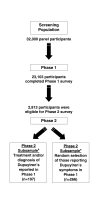Prevalence, incidence, and treatments of Dupuytren's disease in the United States: results from a population-based study
- PMID: 21776198
- PMCID: PMC3092891
- DOI: 10.1007/s11552-010-9306-4
Prevalence, incidence, and treatments of Dupuytren's disease in the United States: results from a population-based study
Abstract
Background: This large population-based study was conducted to estimate the prevalence of Dupuytren's disease in US adults and describe associated treatment patterns.
Methods: A total of 23,103 individuals from an Internet-based research panel representative of the US population completed a brief online survey designed to identify individuals with symptoms, diagnoses, and/or treatment experience indicative of Dupuytren's disease (mean age = 50 years).
Results: The prevalence of Dupuytren's disease defined as a self-reported physician diagnosis and/or surgical treatment was estimated as 1% (95% CI = 0.8-1.2), but the estimated prevalence is much higher (7.3%) when including self-reported symptoms of ropelike growth or hard bumps on the hand. The annual incidence proportion was estimated at about 3 cases per 10,000 adults. A total of 326 participants who reported relevant Dupuytren's symptoms, treatment, and/or diagnosis completed a more in-depth survey focusing on timing of medical treatments after first symptom noticed, description of functional impairment, treatment patterns, and family history. From the second survey, most patients who reported seeking treatment for hand symptoms initially saw a primary care physician, and the mean time from noticing the first hand symptom to seeing a doctor was 23.1 months. At their first doctor visit for hand symptoms, only 9% of patients received a diagnosis of Dupuytren's disease and 48% were advised to "wait and see" or received no treatment.
Conclusions: Results from the current study indicate a number of unmet medical needs, so strategies to raise physician awareness of disease symptoms and effective treatment options may be helpful.
Keywords: Dupuytren’s; Epidemiology; Incidence; Prevalence; Survey; Treatment; United States.
Figures

References
-
- Bayat A, Cunliffe EJ, McGrouther DA. Assessment of clinical severity in Dupuytren’s disease. Br J Hosp Med. 2007;68:604–609. - PubMed
-
- Bergenudd H, Lindgarde F, Nilsson BE. Prevalence of Dupuytren’s contracture and its correlation with degenerative changes of the hands and feet and with criteria of general health. J Hand Surg Br. 1993;18B:254–257. - PubMed
LinkOut - more resources
Full Text Sources
Other Literature Sources

